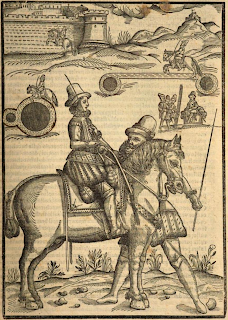TABLE OF CONTENTS / EXPLENATIONS
I want to create here a source of knowledge for people who are interested in the technical details of classical equestrian maneuvers from the Renaissance period. I address this blog mainly to riders aspiring to ride in the style of that historical period.
---------------------------------------------------------------------------------------
TABLE OF CONTENTS:
Brave horse Abin
In Europe there was one common canon of the horse riding art as is described here in one of the articles. In fact the 16th-17th centuries were also the period of the emergence of the classical European equestrian art. These are the times of Fedreico Grisone, Claudio Corte, Antoine de Pluvinel, William Cavendish, Cesare Fiaschi, Krzysztof Dorohstajski, Krzysztof Pieniążek, the first equestrian academies, beautiful costumes and tactical maneuvers used by cavalry in the battle.
Due to the original purpose of these exercises they consist of the basics such as: straight lines, circles, stops, pirouettes, lead changes, or backing up. It is often heard that dressage has its grounds in preparing a horse for combat maneuvers. Here it will be clearly visible.
In the methodology, I will focus here more on the 16th-17th century Italian treaties, without diving into the later maelstrom of equestrian history after the main equestrian culture center moved to France. Sometimes, however, I will have to go beyond the assumed period in order to better explain specific nuances and refer to masters of other nationalities to confirm a technique of a given maneuver.
I do not want to present myself as a trainer on these pages. I just want to show how the performance of the exercises could look with better or worse quality and focus as much as possible on their technical details so that it could serve other conscious riders as solid information. The information contained here is not intended to learn how to ride, but rather how to use the acquired skills.
I will also describe here the riding equipment used at that time (making them is my work - WEBSITE) such as saddles, curbs, bridles, stirrups, spurs, girths, breastplates, saddle pads, cruppers and many others.
I will try to improve, clarify and expand the information on an ongoing basis. If I will make a mistake in the translation, I will try to correct it over time.
You also can help in the development of this blog. If you are capable to technically perform the described maneuvers on the horseback, I will be grateful to publish your videos here. If you want to help translating fragments of old German, French or Italian treatises, I also invite you to cooperate.
The Englishman William Cavendish wrote in 1658:
“Ce Noble & Excellent Art fut premierement commencé & inventé en Italie, ou tous les François & plusieurs d'autres Nations alloient pour l'apprendre."
“This noble and perfect art [of horse riding] was first begun and invented in Italy, where all the Frenchmen and many other nations went to learn it.”
So let's do it and refer to the Italian masters.






